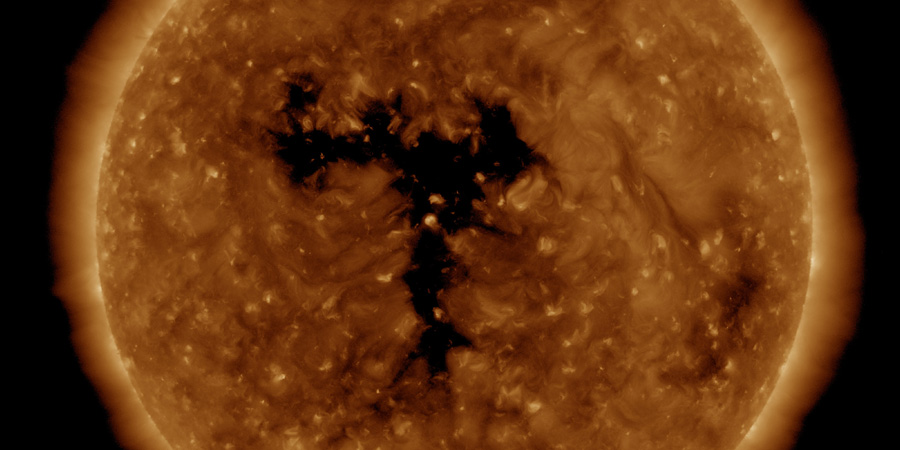Coronal hole faces Earth, Strange solar wind data?
Wednesday, 28 August 2019 17:14 UTC

A T-shaped coronal hole is facing our planet today and sending a high speed solar wind stream towards our planet. High latitude sky watchers be alert for aurora in a few days time!
We admit, the first coronal hole that we talked about here didn't really brought us the geomagnetic activity that we hoped for. That was a small coronal hole but it packed a bigger punch at STEREO A than it did here on Earth. We reached a maximum Kp of 3 yesterday which is enough for some high latitude locations but still rather lackluster for the average coronal hole.
However, what we also talked about last time around was a second coronal hole and that coronal hole is facing our planet today. The coronal hole that is facing our planet today is much bigger in size and while size doesn't always matter, it often does in space weather. In fact, its very likely that today's coronal hole will pack a bigger punch. Looking at the data from STEREO Ahead we see that the solar wind speed went up to 700km/s when the stream passed that space craft. The denser shock ahead of the fast stream pushed the Bz to about -10nT so all in all very decent numbers. What does that mean for us here on Earth? Aurora in a few days time! Active geomagnetic conditions (Kp4) should be possible if we get similar conditions here at Earth and with a bit of luck we might reach minor G1 storm conditions. The solar wind stream flowing from this coronal hole should reach us on Saturday which would be 31 August. Expect the strongest geomagnetic activity on that date and on 1 September.
A northern hemisphere coronal hole is facing Earth. Enhanced solar wind could arrive in ~3 days - Follow live on https://t.co/bsXLidnzGh pic.twitter.com/nXFZ0gdwlO
— SpaceWeatherLive (@_SpaceWeather_) August 28, 2019
Good times ahead for aurora chasers but now that we got your attention there is one more thing we'd like to inform you about. We keep seeing a lot of comments on social media about the huge spikes that sometimes appear in the solar wind density and speed data. We again would like to inform you that the real time solar wind data that you are looking at is not coming from DSCOVR. It is the Advanced Composition Explorer (ACE) space craft that has been providing us with real time solar wind data for more than two months now. DSCOVR remains in safe hold due to a problem with one of the space craft's gyros and is not sending any scientific data back to Earth. That is why ACE is now the primary source of real time solar wind data. These spikes that occur in the solar wind data from time to time are a common problem with ACE and should be ignored. Think about it. ACE is now 22 years old. What electronic item do you own that has been on non stop for 22 years, been battered by solar wind and cosmic rays and still functions pretty much as intended? Exactly. We're really happy that ACE remains operational even after all these years. The real time solar wind data is a crucial tool in every aurora chasers toolbox. Thank you ACE!
Thank you for reading this article! Did you have any trouble with the technical terms used in this article? Our help section is the place to be where you can find in-depth articles, a FAQ and a list with common abbreviations. Still puzzled? Just post on our forum where we will help you the best we can!
Latest news
Latest forum messages
Support SpaceWeatherLive.com!
A lot of people come to SpaceWeatherLive to follow the Sun's activity or if there is aurora to be seen, but with more traffic comes higher server costs. Consider a donation if you enjoy SpaceWeatherLive so we can keep the website online!

Space weather facts
| Last X-flare | 2025/03/28 | X1.1 |
| Last M-flare | 2025/04/01 | M2.5 |
| Last geomagnetic storm | 2025/03/27 | Kp5 (G1) |
| Spotless days | |
|---|---|
| Last spotless day | 2022/06/08 |
| Monthly mean Sunspot Number | |
|---|---|
| February 2025 | 154.6 +17.6 |
| April 2025 | 152.5 -2.1 |
| Last 30 days | 130.7 -17.9 |


